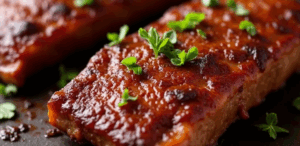Chicken Stock Recipe Slow Cooker
Homemade Chicken Stock: Best Slow Cooker Recipe

There’s nothing quite like a rich, flavorful homemade chicken stock, and making it in a slow cooker is one of the easiest and most rewarding ways. As a chef, I always recommend making your own stock—it’s healthier, tastier, and adds depth to any dish you prepare. Let’s go step-by-step through the full process, covering everything from basic recipes to variations, cooking methods, storage, and even diet-friendly tips.
- Ingredients for Homemade Chicken Stock
- Preparing Homemade Chicken Stock: Whole Bird vs. Parts
- Temperature and Cooking Time for Chicken Stock
- How to Make Homemade Chicken Stock: Step-by-Step
- Spices and Seasonings for Chicken Stock
- Calories and Nutrition of Homemade Chicken Stock
- Making a Diet-Friendly Chicken Stock
- First Courses Using Homemade Chicken Stock
- Main Courses Using Homemade Chicken Stock
- Alternative Methods for Making Chicken Stock
- Secrets to Perfect Slow Cooker Chicken Stock
- Storage, Freezing, and Using Stock
- FAQ About Homemade Chicken Stock
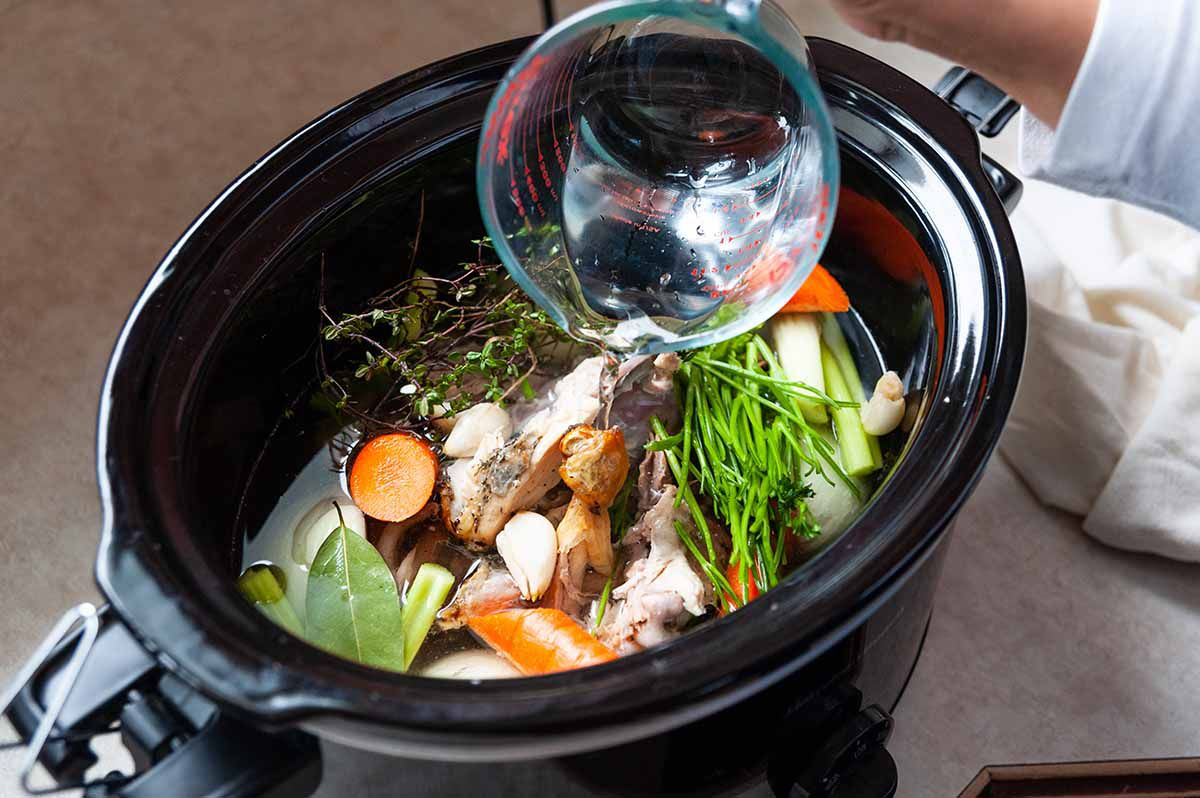
Ingredients for Homemade Chicken Stock
Basic Ingredients
- 1 whole chicken carcass (or 2-3 pounds chicken parts: wings, backs, necks)
- 2 carrots, roughly chopped
- 2 celery stalks, roughly chopped
- 1 large onion, quartered
- 4 cloves garlic, smashed
- 2 bay leaves
- 10 peppercorns
- Fresh herbs (parsley, thyme, dill)
- 10 cups cold water
Optional Add-ins
- Leek tops
- Mushroom stems
- A few sprigs of rosemary
- Lemon peel for brightness
Preparing Homemade Chicken Stock: Whole Bird vs. Parts
Whole Chicken Stock
When I have a whole bird, I simmer it intact first, then remove the meat after 2 hours. I return the bones to the slow cooker for richer flavor. This gives both stock and shredded chicken for other meals.
Parts-Only Stock
Often, I simply save carcasses, wing tips, or necks. Using just parts produces a pure, collagen-rich stock perfect for soups and risottos.
Temperature and Cooking Time for Chicken Stock
| Type | Temperature Setting | Cooking Time |
| Whole Chicken | Low | 8-10 hours |
| Parts (bones/carcass) | Low | 10-12 hours |
| High Setting (urgent) | High | 5-6 hours |
Slow and low gives the best results—deep, rich, golden broth.
How to Make Homemade Chicken Stock: Step-by-Step
Preparation
- Place bones, vegetables, and herbs into the slow cooker.
- Add cold water, covering everything by at least 1 inch.
Cooking
- Set the cooker to Low.
- Let simmer for 8–12 hours.
- Occasionally skim foam from the top if desired (not critical with slow cookers).
Straining and Storing
- Carefully strain stock through a fine-mesh sieve.
- Discard solids.
- Cool completely before storing.

Spices and Seasonings for Chicken Stock
I keep seasoning simple while making stock and adjust when using it in recipes. Here’s what I recommend:
- Peppercorns (always!)
- Bay leaves for depth
- Fresh herbs for a clean aroma
- A touch of salt only if you plan to drink the broth plain (otherwise, season later when cooking)
Calories and Nutrition of Homemade Chicken Stock
- Plain Chicken Stock (per 1 cup):
- Calories: ~40 kcal
- Protein: 5-6 g
- Fat: 1-2 g
- Carbs: 1 g or less
Rich stocks may be higher in fat if you include skin or don’t skim the fat layer after chilling.
Making a Diet-Friendly Chicken Stock
Whenever I want a lighter, diet-friendly stock:
- I use skinless chicken parts to reduce fat.
- I avoid adding starchy vegetables like potatoes.
- I skim any fat layer that rises after chilling the stock overnight.
This results in a clear, low-calorie broth that’s perfect for healthy eating.
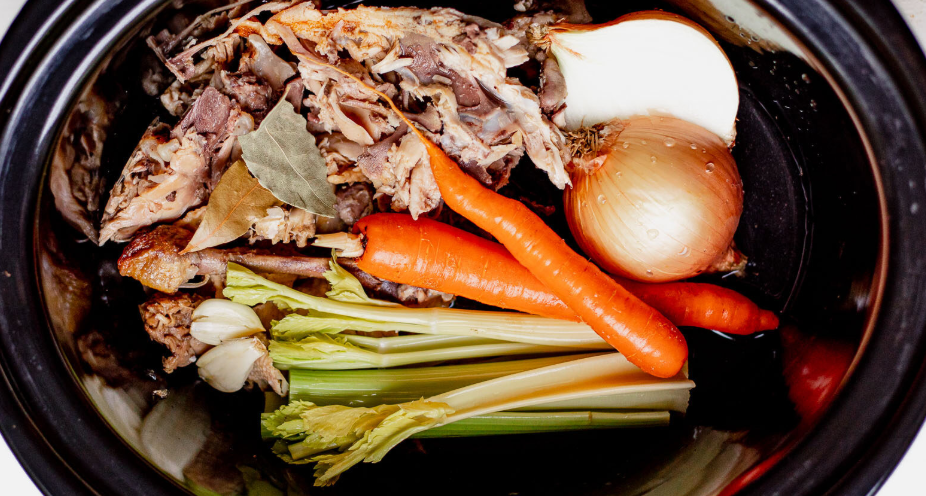
First Courses Using Homemade Chicken Stock
- Classic Chicken Soup:
Add shredded chicken, noodles, and fresh vegetables to your stock.
- Brothy Vegetable Soup:
Simply simmer seasonal veggies in your homemade stock for a light, nourishing starter.
Main Courses Using Homemade Chicken Stock
- Risotto:
I always use homemade stock in risotto for creamy texture and rich taste.
- Chicken and Dumplings:
A hearty dish using thickened chicken stock as the base.
- Stews and Braises:
Beef stew or pot roast tastes infinitely better with rich chicken stock instead of water.
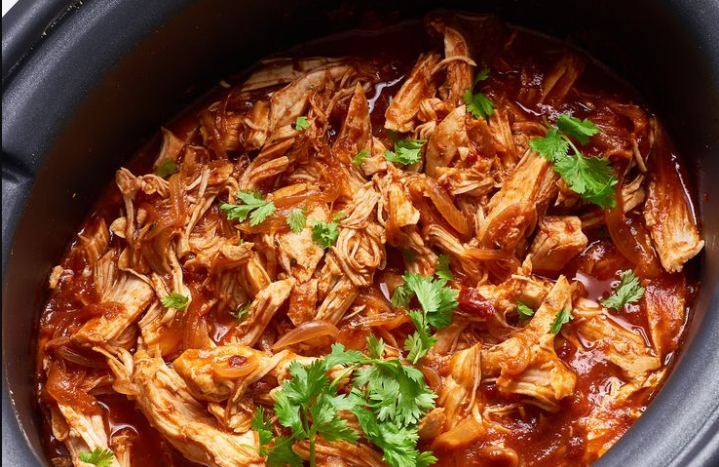
Alternative Methods for Making Chicken Stock
Slow Cooker (Preferred)
Best method for hands-off, overnight cooking.
Microwave
Not recommended. Microwaving does not allow proper extraction of collagen and flavor.
Multicooker (Pressure Cooker Mode)
I sometimes use a multicooker (like Instant Pot) to pressure-cook the stock:
- 45 minutes on high pressure = stock comparable to 8 hours in a slow cooker.
Stovetop
Simmer uncovered for 6–8 hours, adding water as needed.
Oven (Low Heat)
Roast bones first for deep flavor, then bake stock at 250°F in a covered Dutch oven for 8 hours.
Clay Pot
Slow-cooking in clay pots produces rich, earthy-tasting stock, though it takes longer (12+ hours).
Secrets to Perfect Slow Cooker Chicken Stock
- Roast the Bones:
I always roast the bones at 400°F for 30 minutes before starting the stock to add depth.
- Cold Start:
Starting with cold water gives a clearer stock.
- Long, Gentle Simmer:
I never rush stock; time unlocks maximum flavor and collagen extraction.
- Minimal Stirring:
Stirring during cooking clouds the broth. I let everything settle naturally.
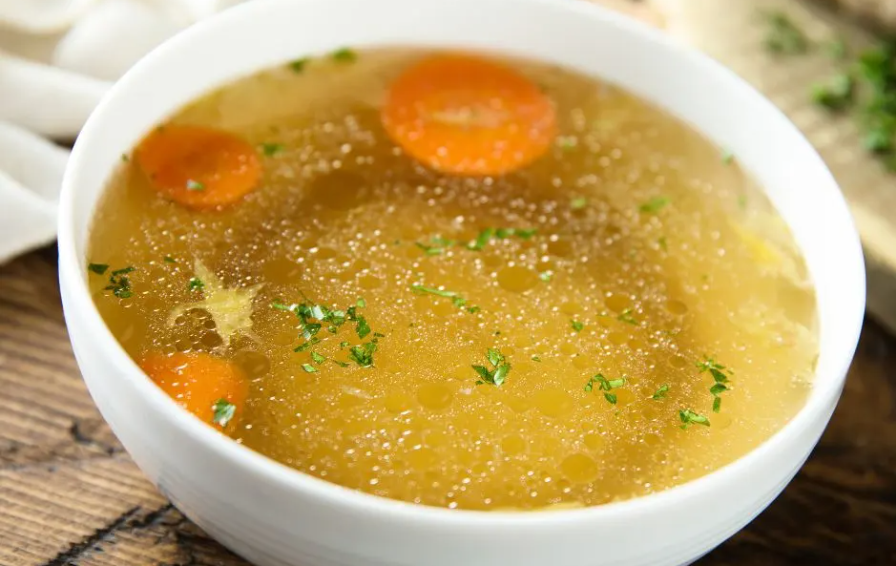
Storage, Freezing, and Using Stock
- Refrigerate for up to 5 days.
- Freeze in portions (ice cube trays, small containers) for up to 6 months.
- Always label with the date and whether it’s salted.
Pro Tip: I reduce stock by half before freezing to save space, then reconstitute with water when needed.
FAQ About Homemade Chicken Stock
Should I use raw or cooked bones?
In my experience, roasted bones give richer, deeper flavor. I always prefer roasting first.
Can I add salt during cooking?
I usually don’t. It’s better to salt the final dish, not the stock, for maximum flexibility.
How do I make a gelatinous stock?
I use parts rich in collagen like wings, feet, and necks. A wobbly stock when chilled is a good sign!
Can I reuse bones?
I’ve tried “remouillage” (second stock), but it’s always much weaker. I usually don’t bother.
How do I get clear stock?
I simmer slowly without stirring and strain carefully without pressing solids.
Should I peel vegetables first?
For stock, I don’t bother peeling carrots or onions. The skins add color and nutrients.
How much water should I use?
I cover everything by about 1 inch. Too much water = thin, watery stock.
Can I add vinegar?
I sometimes add a splash of apple cider vinegar to help extract minerals from the bones.
What’s the difference between broth and stock?
Stock is made primarily from bones; broth often includes more meat. I use them interchangeably in everyday cooking.
Can I make stock with just chicken meat?
Yes, but it’ll lack the gelatin richness that bones provide.
Should I skim foam?
In slow cookers, foam is minimal. I usually don’t bother skimming.
Can I cook stock too long?
If cooked beyond 24 hours, I notice a bitter, over-extracted taste. 10-12 hours is ideal.
Is homemade stock better than store-bought?
Without a doubt. The flavor, nutrition, and lack of preservatives are unbeatable.
What herbs are best for chicken stock?
I love using parsley, thyme, and bay leaves. Dill is excellent too if used sparingly.
Can I freeze stock in glass jars?
Yes, but I always leave an inch of space at the top for expansion to prevent breakage.



